
Alpinia is a genus of flowering plants in the ginger family, Zingiberaceae. Species are native to Asia, Australia, and the Pacific Islands, where they occur in tropical and subtropical climates. Several species are cultivated as ornamental plants.
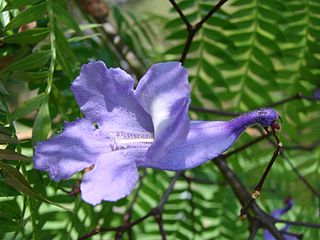
Jacaranda is a genus of 49 species of flowering plants in the family Bignoniaceae, native to tropical and subtropical regions of the Americas while cultivated around the world. The generic name is also used as the common name.
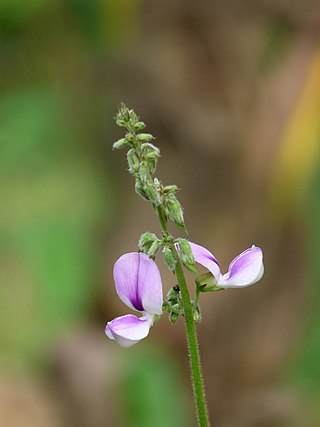
Pueraria is a genus of 15–20 species of legumes native to south, east, and southeast Asia and to New Guinea and northern Australia. The best known member is kudzu, also called Japanese arrowroot. The genus is named after 19th century Swiss botanist Marc Nicolas Puerari.
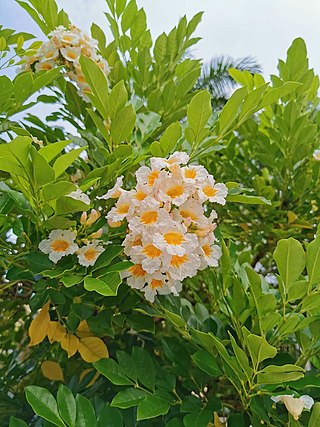
Radermachera is a genus of about 17 species of flowering plants in the family Bignoniaceae, native to southeastern Asia. They are evergreen trees reaching 5–40 m tall, with bipinnate or tripinnate leaves, and panicles of large bell-shaped, white, pink, pale purple or yellow flowers 5–7 cm diameter.

Bignonia is a genus of flowering plants in the family Bignoniaceae. Its genus and family were named after Jean-Paul Bignon by his protégé Joseph Pitton de Tournefort in 1694, and the genus was established as part of modern botanical nomenclature in 1753 by Carl Linnaeus. Species have been recorded from the southern USA, Central to most of South America.

Stereospermum is a genus of trees in the paleotropical clade of the family Bignoniaceae. A species of Stereospermum is used in herbal medicine in Ayurveda as well as it is an integral part of the culture and tradition of the cold desert biosphere reserve.
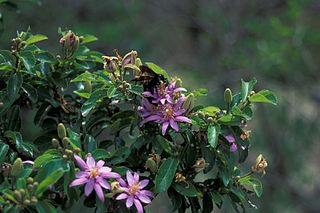
Grewia is a large flowering plant genus in the mallow family Malvaceae, in the expanded sense as proposed by the Angiosperm Phylogeny Group. Formerly, Grewia was placed in either the family Tiliaceae or the Sparrmanniaceae. However, these were both not monophyletic with respect to other Malvales - as already indicated by the uncertainties surrounding placement of Grewia and similar genera - and have thus been merged into the Malvaceae. Together with the bulk of the former Sparrmanniaceae, Grewia is in the subfamily Grewioideae and therein the tribe Grewieae, of which it is the type genus.
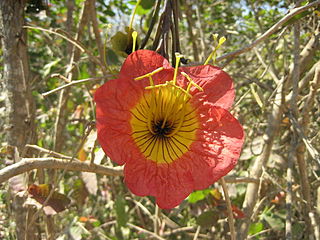
Fernandoa is a genus of plants in the family Bignoniaceae; species are found in tropical Africa, India and south-east Asia.

Leptactina is a genus of flowering plants in the family Rubiaceae. There are about 27 species. They are all native to sub-Saharan Africa, where most occur in rainforest habitat.

Randia, commonly known as indigoberry, is a mostly Neotropical genus of shrubs or small trees in the Rubiaceae. As of February 2022 Plants of the World Online lists a total of 112 accepted species in the genus. Several Australian species have been reassigned to the genus Atractocarpus. These include the garden plants Atractocarpus chartaceus and A. fitzalanii.

Helicteres is a genus of flowering plants in the family Malvaceae. Its range is from tropical and sub-tropical Asia through to northern Australia, and also Mexico through to the northern half of South America.
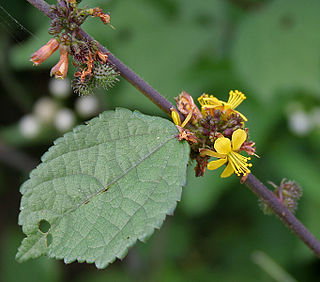
Triumfetta is a genus of plants in the family Malvaceae. Burbark is a common name for plants in this genus.
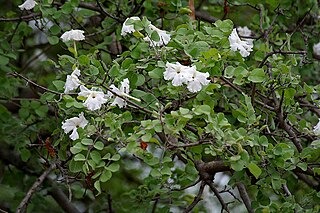
Dolichandrone is a genus of flowering plants in the family Bignoniaceae.

Baissea is a genus of plant in the family Apocynaceae found in tropical Africa. As of August 2013 the World Checklist of Selected Plant Families recognises 18 species:

Pleiocarpa is a genus of plant in the family Apocynaceae first described as a genus in 1876. It is native to tropical Africa from Senegal to Tanzania and south to Zimbabwe. As of August 2013 the World Checklist of Selected Plant Families recognises 6 species:
- Pleiocarpa bicarpellataStapf - Cabinda, Cameroon, Republic of the Congo, Gabon, Democratic Republic of the Congo, Kenya
- Pleiocarpa brevistylaOmino - Gabon
- Pleiocarpa muticaBenth. - Ghana, Ivory Coast, Liberia, Sierra Leone, Nigeria, Cameroon, Gabon, Central African Republic, Republic of the Congo
- Pleiocarpa picralimoides(Pichon) Omino - Cabinda, Republic of the Congo, Gabon
- Pleiocarpa pycnantha(K.Schum) Stapf - widespread across most of tropical Africa
- Pleiocarpa rostrataBenth. - Nigeria, Cameroon, Gabon
- Pleiocarpa camerunensis(K.Schum. ex Hallier f.) Stapf = Hunteria camerunensisK.Schum. ex Hallier f.
- Pleiocarpa hockiiDe Wild. - Acokanthera oppositifolia(Lam.) Codd
- Pleiocarpa simii(Stapf) Stapf ex Hutch. & Dalziel = Hunteria simii(Stapf) H.Huber

Ferdinandusa is a genus of flowering plants in the family Rubiaceae, native to the American tropics.

Markhamia zanzibarica, also known as bell bean tree or maroon bell-bean, is a species of plant in the family Bignoniaceae. It is found in East Africa and Southern Africa, from Kenya to South Africa.
Xylophragma is a genus of flowering plants in the family Bignoniaceae, native to dry forests of Mexico, Central America, Trinidad and northern South America. They are lianas or scandent shrubs.

Heterophragma is a genus of two species of tree, constituting part of the plant family Bignoniaceae. The species are found in Southeast Asia and India.

Sparattosperma is a genus of flowering plants belonging to the family Bignoniaceae.




















